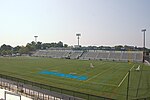Cathedral of the Incarnation (Baltimore)
1916 establishments in Maryland20th-century Episcopal church buildingsCathedrals in MarylandChurches completed in 1955Churches in Baltimore ... and 4 more
Episcopal cathedrals in MarylandEpiscopal church buildings in MarylandGothic Revival church buildings in MarylandNorthern Baltimore

The Cathedral of the Incarnation is an Episcopal cathedral in the Guilford neighborhood of Baltimore, Maryland, United States. It is the seat of the Diocese of Maryland. In 2020, it reported 721 members, 227 average attendance, and plate and pledge income of $489,369.
Excerpt from the Wikipedia article Cathedral of the Incarnation (Baltimore) (License: CC BY-SA 3.0, Authors, Images).Cathedral of the Incarnation (Baltimore)
East University Parkway, Baltimore
Geographical coordinates (GPS) Address Website External links Nearby Places Show on map
Geographical coordinates (GPS)
| Latitude | Longitude |
|---|---|
| N 39.332155555556 ° | E -76.616661111111 ° |
Address
Cathedral of the Incarnation
East University Parkway 2
21218 Baltimore
Maryland, United States
Open on Google Maps





